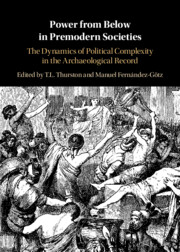 Power from Below in Premodern Societies
Power from Below in Premodern Societies A Bottom-Up Approach
Published online by Cambridge University Press: 08 October 2021
This volume is like déjà vu – here we are again trying to break away from hierarchy. In 2009, a major conference on social formations set an ambitious dual agenda: to summarize the research on that subject up to this point with a strong critique of the favored but not always justified hierarchical approach, and to offer a range of alternatives to studying and understanding human organization (Kienlin, 2012). This conference came after years of excellent scholarship on the development of contrary models (e.g. Crumley, 1987; Friedman & Rowlands, 1977) to the study and proliferation of hierarchical societies (or what are assumed to be hierarchical societies) that dominate our discipline. The contributions to this volume are part of the same cycle of the utter predominance of approaches equating power with hierarchy and centralization that are periodically challenged by the increasing number of archaeological case studies for which such approaches simply do not work.
To save this book to your Kindle, first ensure [email protected] is added to your Approved Personal Document E-mail List under your Personal Document Settings on the Manage Your Content and Devices page of your Amazon account. Then enter the ‘name’ part of your Kindle email address below. Find out more about saving to your Kindle.
Note you can select to save to either the @free.kindle.com or @kindle.com variations. ‘@free.kindle.com’ emails are free but can only be saved to your device when it is connected to wi-fi. ‘@kindle.com’ emails can be delivered even when you are not connected to wi-fi, but note that service fees apply.
Find out more about the Kindle Personal Document Service.
To save content items to your account, please confirm that you agree to abide by our usage policies. If this is the first time you use this feature, you will be asked to authorise Cambridge Core to connect with your account. Find out more about saving content to Dropbox.
To save content items to your account, please confirm that you agree to abide by our usage policies. If this is the first time you use this feature, you will be asked to authorise Cambridge Core to connect with your account. Find out more about saving content to Google Drive.